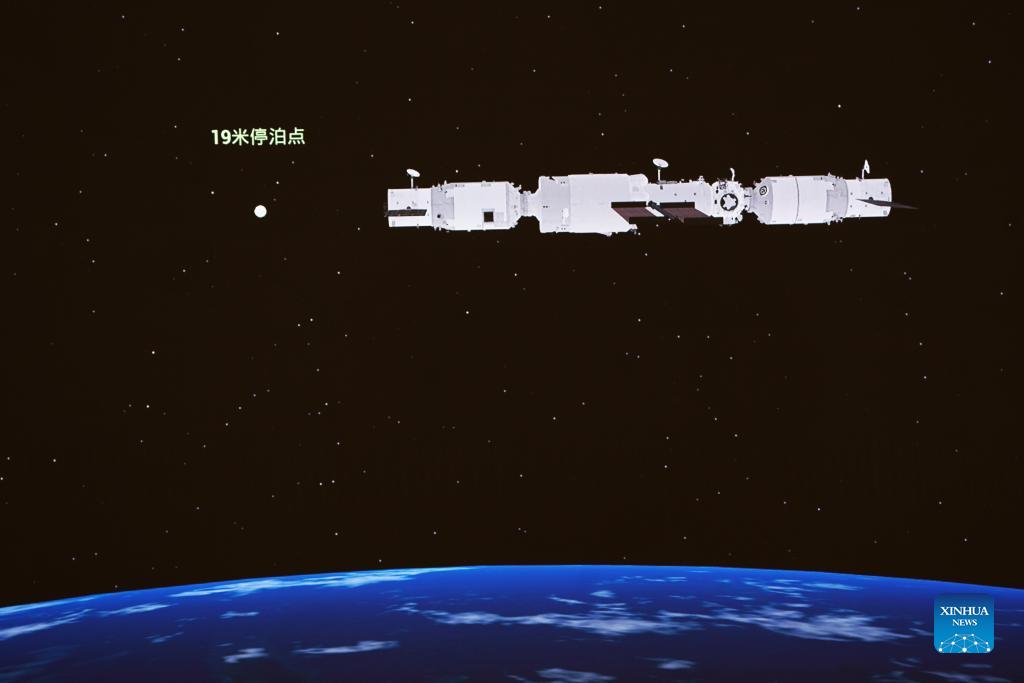
Screen image captured at Beijing Aerospace Control Center on Sept. 20, 2021 shows China's cargo spacecraft Tianzhou-3 docking with the space station core module Tianhe. (Photo by Guo Zhongzheng/Xinhua)
BEIJING, Sept. 20 (Xinhua) -- China's cargo spacecraft Tianzhou-3, carrying supplies for the upcoming Shenzhou-13 crewed mission, successfully docked with the space station core module Tianhe on Monday, according to the China Manned Space Agency (CMSA).
At 10:08 p.m. (Beijing Time), Tianzhou-3 completed a computer-orchestrated rendezvous and docking at the rear docking port of the Tianhe core module. The whole process took approximately 6.5 hours, the CMSA said.
The Long March-7 Y4 rocket, carrying Tianzhou-3, blasted off at 3:10 p.m. from the Wenchang Spacecraft Launch Site in the southern island province of Hainan. After 597 seconds, Tianzhou-3 separated from the rocket and entered its designated orbit. At 3:22 p.m., the solar panels of Tianzhou-3 unfolded and began working properly.
The CMSA declared the launch a complete success.
On Sept. 18, the Tianzhou-2 cargo craft separated from the rear docking port of Tianhe and docked with its front docking port.
Following Tianzhou-3's docking, the two cargo crafts are docked at the two ends of the Tianhe core module to form a linear shape, waiting for the arrival of Shenzhou-13 crew members.
Monday's launch is the 20th mission of China's manned space programs and the 389th mission of the Long March rocket series.
Zhong Wen'an, chief engineer at the Xichang Satellite Launch Center, said that the Tianzhou-3 mission is the second flight of China's space station cargo transportation system, composed of the Tianzhou spacecraft and the Long March-7 rockets. The mission is key to connecting the preceding verification of key technologies and the following in-orbit construction.
As the ancient Chinese said, to carry out an important task, supplies like rations and forage should go ahead of troops and horses. During the construction of the space station, cargo spaceships will always be launched ahead of crewed missions.
"We will transport support materials, necessary spare parts and equipment first, and then our crew," said CMSA Director Hao Chun.
Tianzhou-3 carries nearly 6 tonnes of goods and materials, including living supplies for the astronauts, one extravehicular space suit for back-up, supplies for extravehicular activities, space station platform materials, payloads and propellants.
The cargo can ensure sufficient food and drinking water for three astronauts to remain in orbit for six months. While Tianzhou-2 had two tonnes of propellant on board, Tianzhou-3 cancelled four propellant storage tanks and carried only 750 kg of propellant to deliver more supplies for the Shenzhou-13 crew.
The color of the packages has been updated to help astronauts identify the contents. The packages on Tianzhou-2 featured markings and QR codes to identify the contents, but as the packaging was all beige, they were a little hard for astronauts to sort and organize. On Tianzhou-3, the supplies are packaged in different colors and with a QR code.
Feng Yong is the chief director of the Tianzhou-3 cargo craft at the China Academy of Space Technology (CAST). He said that Tianzhou-3 carries gas cylinders, the internal pressure can reach 300 times atmospheric pressure. Tanks of this sort containing oxygen can supply astronauts for long periods.
Meanwhile, the cargo freighter also carries water bags made of light and soft materials. The design ensures the safety of drinking water, but also allows for the organized storage of empty water bags.
Wang Ran, a CAST designer for Tianzhou-3, said that most goods carried by Tianzhou-3 were loaded in standard packages. The packages have good mechanical bearing properties and are also antibacterial, mold proof, flame proof and have no harmful gas volatilization.
Wang said the Tianzhou cargo packaging materials make use of a unique ingredient extracted from crab shells.
Following the Tianzhou-3 mission, the Shenzhou-13 manned spaceship will be launched to dock with the core module Tianhe, and three astronauts will then begin their six-month stay in orbit.
China plans to complete the verification of key technologies and the in-orbit construction of the space station through multiple launches within two years.
Five launch missions are planned for this year, namely the launch of the Tianhe core module, Tianzhou-2 cargo ship, Shenzhou-12 crewed mission, Tianzhou-3 cargo ship and the upcoming Shenzhou-13 crewed mission.
Six more missions will come in 2022, including the launch of the Wentian and Mengtian lab modules, two cargo spacecraft and two crewed spaceships, to complete the construction of the space station. Enditem




